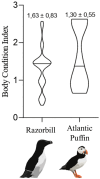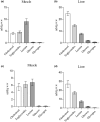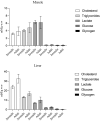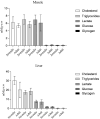Body condition of stranded Razorbills and Atlantic Puffins in the Western Mediterranean
- PMID: 39263463
- PMCID: PMC11387722
- DOI: 10.1002/ece3.70161
Body condition of stranded Razorbills and Atlantic Puffins in the Western Mediterranean
Abstract
Annual mass migrations of seabirds between their breeding and wintering grounds are critical for ensuring their survival and reproductive success. It is essential to comprehend their physical condition in order to identify the causes of death and to facilitate conservation efforts. This study focuses on evaluating the age, body condition index, and metabolites in liver and muscle (triglycerides, glycerol, glycogen, cholesterol, lactate, and glucose) of stranded Razorbills (n = 84) and Atlantic puffins (n = 11). The study was conducted along the Andalusian coast of Spain during the winter season of 2022-2023. The study examined the body condition of stranded individuals and their metabolic state to determine potential factors that may have caused their deaths. The study found that the majority of stranded individuals were juveniles. Both species exhibited low levels of carbohydrate (glucose and glycogen) in their tissues and high levels of lactate in their muscles. These findings could suggest that the individuals had undergone prolonged, strenuous exercise, demanding energy on anaerobic pathways, which may have been associated with migration. The study highlights the significance of adhering to standardized protocols when assessing the body condition of stranded seabirds. Doing so can help to identify causes of death and facilitate conservation efforts. A proposed index for body condition, which incorporates biometric measurements and individual physical condition, provides a comprehensive means of understanding the health of these unique species. This study underscores the importance of further research into the conservation measures and recommendations for protecting seabird populations. It is critical to comprehend the contributing factors of mass mortality incidents to work towards safeguarding these species and preserving their vital migration patterns.
Keywords: body condition assessment; conservation; mass die‐off events; metabolic analysis; stranded seabird.
© 2024 The Author(s). Ecology and Evolution published by John Wiley & Sons Ltd.
Conflict of interest statement
The authors have no conflict of interest.
Figures








Similar articles
-
Mercury in wintering seabirds, an aggravating factor to winter wrecks?Sci Total Environ. 2015 Sep 15;527-528:448-54. doi: 10.1016/j.scitotenv.2015.05.018. Epub 2015 May 14. Sci Total Environ. 2015. PMID: 25984703
-
Sympatric Atlantic puffins and razorbills show contrasting responses to adverse marine conditions during winter foraging within the North Sea.Mov Ecol. 2019 Nov 1;7:33. doi: 10.1186/s40462-019-0174-4. eCollection 2019. Mov Ecol. 2019. PMID: 31695919 Free PMC article.
-
North Atlantic winter cyclones starve seabirds.Curr Biol. 2021 Sep 13;31(17):3964-3971.e3. doi: 10.1016/j.cub.2021.06.059. Curr Biol. 2021. PMID: 34520704
-
International society of sports nutrition position stand: nutrient timing.J Int Soc Sports Nutr. 2017 Aug 29;14:33. doi: 10.1186/s12970-017-0189-4. eCollection 2017. J Int Soc Sports Nutr. 2017. PMID: 28919842 Free PMC article. Review.
-
Carbohydrate ingestion during prolonged exercise: effects on metabolism and performance.Exerc Sport Sci Rev. 1991;19:1-40. Exerc Sport Sci Rev. 1991. PMID: 1936083 Review.
References
-
- Anker‐Nilssen, T. (1988). Age, sex and origins of auks (Alcidae) killed in the Skagerrak oiling incident of January 1981. Seabird, 11, 28–46.
-
- Anker‐Nilssen, T. , Aarvak, T. , & Bangjord, G. (2003). Mass mortality of Atlantic puffins Fratercula arctica off Central Norway, spring 2002: Causes and consequences. Atlantic Seabirds, 5(2), 57–72.
-
- Anker‐Nilssen, T. , Harris, M. P. , Kleven, O. , & Langset, M. (2017). Status, origin, and population level impacts of Atlantic puffins killed in a mass mortality event in southwest Norway early 2016. Seabird, 30, 1–14. 10.61350/sbj.30.1 - DOI
-
- Anker‐Nilssen, T. , Jensen, J. K. , & Harris, M. P. (2018). Fit is fat: Winter body mass of Atlantic puffins Fratercula arctica. Bird Study, 65(4), 451–457. 10.1080/00063657.2018.1524452 - DOI
LinkOut - more resources
Full Text Sources

